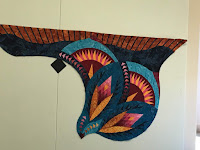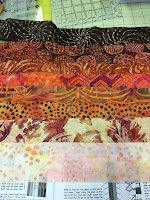Due to the way I sew - multiple projects at a time, I don't finish tops very often. They are spread out over time. But this summer I have been concentrating on finishing a few quilts. The first finish is Spring Meadow.
I started this one at Quiltworx University in Tucson in 2019. The process for Quiltworx University goes like this - everyone (about 50 quilters) does the same mixer. That means a pattern is broken down into 4 sections - center, first border, outer section and outer border. Then, for each section there are anywhere from 4 to 7 different options to choose from. So, even before fabric choices are applied, everyone's quilts will look different. The add fabric and you really have a terrific line up of wildly different quilts. The mixer for QU 2019 in Tucson was Prairie Star Mixer.
I chose my layout options and fabrics on Quiltster, submitted it and like magic it was there, in a box waiting for me when I arrived.
Saul was a good sport and agreed to go with me to Tucson. It was held at Tanque Verde Ranch outside of Tucson, a beautiful desert property with Southwestern buildings and stately Saguaro cacti and colorful scrubs. Oh, and did I mention, the food was delicious - Saul's favorite part.In addition to lovely hours of sewing, we were treated to a trunkshow by Judy. We got to see a bunch of new projects coming out. I always look forward to this and I make a list of what I want to make next.
Fast forward 3 plus years: sweet Saul's passing, COVID, some more travels, and several quilts. In July of this year (2022) I went to Quilt Camp at the Quiltworx retreat and training center, spending 10 days working on Quiltworx quilts with other Quiltworx fans.
I opened the tote with my Meadow Star project and my first thought was "What was I thinking when I used these colors? It looks like the Easter Bunny yacked up on the wall." But as I got all the pieces up on the design wall and began assembling it - especially when I added the Kaffe Collective Cabbage Rose fabric, it all came together. Granted it wasn't my usual color palette, but I liked it.Its 100 inches square and will cost a pretty penny to have it quilted. I've started saving! It feels so good to get one of the beautiful Judy Niemeyer quilts finished. Judy designs them so they are not difficult, but they do take perseverance. Oh, and I started a new one while I was there, so my net Quiltworx project numbers didn't change.
If you're interested in learning more about Judy and Quiltworx, let me know. I have an entire trunkshow dedicated to the beautiful Quiltworx quilts.


















































